October 28, 2010
By Bill Winke
Find future success in lessons from the past.
By Bill Winke
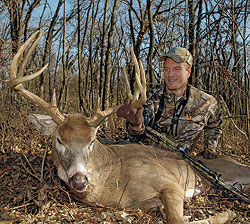 11-16-08 |
Back in the July issue, I wrote about the summer habits of bucks and how their home ranges often change once they shed their velvet and the bachelor groups break up. In that article, I mentioned how few of the bucks I scouted all summer actually showed themselves when hunting season rolled around. I touched a little on the methods I used to pattern the bucks after they disappeared. In this feature, I thought it would be fun to come back with a few highlights to describe what actually happened next: what we shot and the lessons we learned along the way.
November 7
A stiff northwest wind was blowing snow into my eyes. We had barely set up when a giant buck appeared along the edge of the standing cornfield, walking my way. The cameraman quickly got on the buck as I drew my bow and settled the pin on his vitals.
Advertisement
But just as I was squeezing the trigger, my feet flew backwards, I tipped awkwardly and hit the buck low and back. It was disgusting -- I was shocked and bewildered until I figured out what happened.
The cameraman, in his effort to move and get a better angle, had unknowingly bumped my stand. I was leaning over a branch, and with the stand moving backward slightly, that was all it took to make my cantilevered frame tip forward -- right at the moment the trigger broke over. We looked for the buck the next day but never found even a single drop of blood. I had never seen this buck before, and he taught me little beyond what I already knew: hunt your best stands on the best days -- and don't use cheap, insecure treestands!
Advertisement
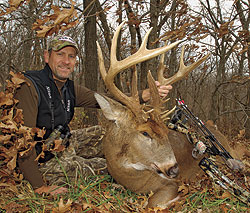 11-12-08 |
November 9
Still licking my wounds, I headed out Nov. 9 to another of my better stands. The wind was still from the northwest, and it was cold -- around 20 degrees. The week from Nov. 3-10 is the best of the season, assuming cool temperatures, and I was still in that window.
So, I hoped for redemption. Actually, this stand was only a quarter-mile from where I had hit the buck two days earlier, and I dreamed he might come past. The stand overlooks an open gate deer funnel through as they move among three ridgetops. It is a natural spot to ambush a cruising buck during the rut.
Shortly after sunrise, a great buck did appear, but it wasn't the one I had hoped for.
However, this buck was too big to pass up. So, as he started walking my way, I whispered at Thad DeMoss to keep the camera rolling. At a range of just 12 yards, I grunted and stopped the buck in the gateway for an easy shot that resulted in a quick recovery. It was sure good to see him fall within view! As it turned out, this was a buck I had several photos of from other parts of the farm. He was obviously visible and active. It was not surprising, given what I had learned about patterning deer in the past year, that I was able to see this buck from a stand.
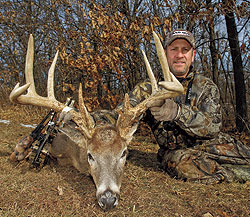 01-12-09 |
When you pick up a certain buck repeatedly on your trail cameras in late September or October, you have a buck you can likely kill in that area.
This buck also reinforced two points regarding strategy. He was using an open gate -- a great funnel -- as he cruised between bedding areas. The funnel could be anything: a ditch, a bluff, an inside corner, a fencerow, etc. The proximity to areas (ridgetops) where does regularly bed is the reason he came past. In the morning, during the rut, there is no better place to hunt than a stand near a doe bedding area, or in a stand between two such places.
November 12
As a landowner in Iowa, I can shoot two bucks with my bow during the rut. So, I still had another tag in my pocket. My friend Mike Sawyer also was hunting our farm last year, and on Nov. 11, his cousin and cameraman (we film all our hunts now) had to leave. That meant that either Mike had to leave a day earlier than planned, hunt without a camera (not allowed) or I needed to go with him. I decided I would take him out. We each had a bow in the tree and a camera mounted between us. I had the option at any point of shooting and asking Mike to film it. So technically, we were both hunting and both filming.
That afternoon, we climbed into stands about 100 yards off a ridgetop alfalfa field, on a secondary ridge that leads to the main ridge. The spot really doesn't make all that much sense by itself. However, it is the only location I felt I could hunt effectively in that area, because I can get in and out without spooking deer and the wind blows my scent off the secondary ridge, away from the noses of any nearby deer. You just hope something comes through. It is not a no-brainer stand, by any means; merely an access point to hunt a fresh area. Sometimes, that is the best you can hope for -- not all setups have it all.
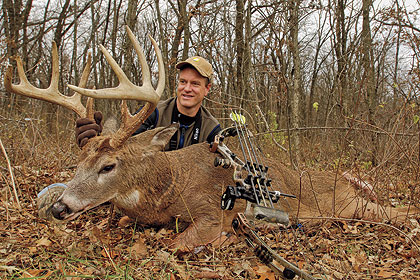 11-09-08 |
Shortly after we got in the stand, a big-bodied deer came over the top of the alfalfa field and headed toward the timber where we were sitting. I took a quick look with binos and immediately recognized him as a buck we had filmed on that field in late August, none other than the buck we called "Stickers." He was an old buck, and for him to be on his feet, alone, early in the afternoon, during the middle of the breeding phase of the rut, could mean only one thing -- there weren't many does around. He was looking.
As Stickers worked his way through the edge of the timber and then crested back out onto the edge of the alfalfa field, Mike tried grunting at him. I had already decided Mike could shoot the buck if it came in. I had hung my bow and was behind the camera by this time.
I could tell by the buck's body language he had not heard the calls, so in desperation I snort-wheezed as loudly as possible with my mouth. The buck locked right up, staring our way. Within a few seconds, he turned and started picking his way down the side of the ridge we were guarding. When the buck passed at 20 yards, Mike grunted to stop him and
made a good shot. We watched in awe as he fell within sight; then the celebration broke out.
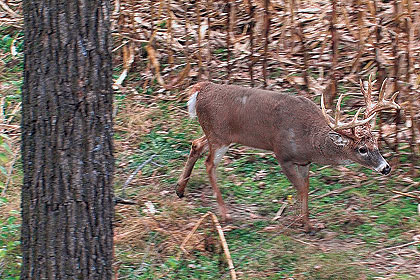 This is a frame taken from the video of the buck BOWHUNTING Field Editor Bill Winke lost Nov. 7. Yes, he really was that close -- 17 yards. |
Upon recovering the deer, we found him even bigger than we expected. He had a huge body that made his antlers look smaller than they actually were. He was a legitimate 170-inch buck with about 15 inches of sticker points. And I had preserved the whole show in high definition! What a treat it was to watch that later.
Mike's buck offers three lessons. First, keeping doe numbers low encourages bucks to cover more ground during the rut and move more during daylight hours. Second, sometimes you have to hunt the best stand you can get to and from effectively, even if it doesn't overlook the area's best sign. I would rather hunt the fringe, see fewer deer and get away with it than hunt the middle, see a bunch of deer and get busted. Third, when bucks don't react to your calling, maybe they simply didn't hear you. Mike was grunting loudly at a buck only 100 yards away. I don't know why he didn't hear it, but he didn't.
The high-pitched snort-wheeze stopped him in his tracks.
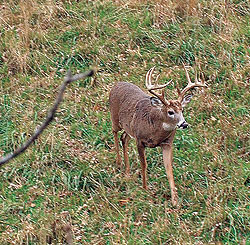 This is a frame taken from the video of the buck BOWHUNTING Field Editor Bill Winke shot Nov. 9. The image was captured shortly before the buck entered the open gate 12 yards from Winke's treestand. |
November 16
I was proud of Mike and excited we had captured his hunt on film. But I still had a tag in my pocket, so I kept hunting hard. On the afternoon of Nov. 16, I was hunting a stand that I had put up about 10 days earlier. We had not hunted it yet. I put it along the edge of a standing cornfield near the area where I had filmed three dandy bucks during the summer. I had no reason to think those bucks were still in the area, and I just hunted it because I wanted to see what might come out. I was just making my rounds.
Drew Yarkosky was filming the hunt; less than an hour after we got into the tree, he hissed, "Here comes a big one!" I was stunned to see a legitimate, mature, shooter buck walking the edge of the cornfield right in the middle of the afternoon. I didn't have a lot of time to size him up, but quickly took the bow off the hook and came to full draw. The buck walked by at just seven yards. I can usually manage seven-yard shots, so once again, we filmed a buck falling within sight.
It wasn't until later that I figured out which buck I had shot. He was, in fact, one of the three bucks we had filmed nearby several times during the summer. I also had photographed this buck about 300 yards away in an open field in early October. As it turned out, he was one of the bucks I had hoped to see from this stand. I had no reason going in (other than the summer footage several months removed) to think anything good might happen that evening. He was the only deer we saw. All I can say is that sometimes, it is better to be lucky than good.
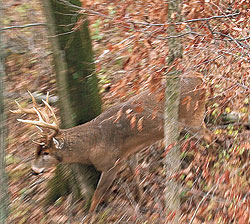 This is a frame taken from the video of the buck Mike Sawyer shot Nov. 12. This was the buck known as "Stickers." |
January 3
The final hunt I'm going to highlight from last season took place Jan. 3. Again, it was lucky Mike Sawyer at the bow. His cousin Chris Mack was filming him. The evening before, Mike had filmed Chris shoot a nice 9-pointer from the same stand with a muzzleloader. So, their hopes that a mature buck would come out were not high. Little did they know€¦
December had been brutal in our part of the Midwest, and a thick blanket of ice covered all the open fields for most of the month. Combined with bitterly cold temperatures, the ice had really stressed the local deer. It was impossible for them to dig for food, given the half-inch of ice on several inches of snow. When the weather finally broke in late December, the deer began moving very aggressively toward any open fields. Mike was there to greet them.
Shortly before sunset, a big, old, mature buck showed up and began easing his way out toward a nearby alfalfa field. Mike had to stand up on his tiptoes in order to shoot over a branch. At a distance of 40 yards, he punched the buck perfectly in the vitals.
I was in my office working, and when Mike called me from his stand with the report, I wasted no time getting over there to help with the recovery. When we finally found him and Mike lifted that buck's head, I was shocked. I had expected a nice, 150-class buck, but what I saw was a sure 180-incher! Again, instead of ground shrinkage, we enjoyed the pleasure of a buck that grew.
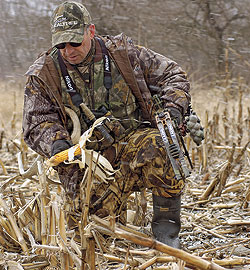 Most of the time, late-season success comes with a cold snap. But in years when the temperatures are consistently cold, a warm spell may be the impetus to get the deer moving. |
We had not seen this buck during the 2008 season. Upon further evaluation, I realized we had his sheds from the year before. We found them nearly two miles from the spot where Mike shot the buck! It always amazes me how much some bucks move from one year to the next and how unique mature bucks really are. They are all individuals. Throw the stereotypes out the window when hunting them.
This buck taught me an important lesson about the late season. Deer react to changes in weather patterns more than they do to the patterns themselves. After weeks of cold and ice, they literally ran to the fields when the temperature finally warmed enough to produce open ground. Most years, it works just the opposite; the cold fronts trigger feeding sprees -- not the warm fronts. So, watch for changes; be out there when the temperature does a flip-flop and you will enjoy better late-season success.
We had a great season, obviously, and I hope you learned something from our experiences. Every season offers valuable lessons if you will take the time to sit down and analyze the events carefully -- even if all you learn is another strategy that doesn't work. I have had plenty of those seasons too. That is the great thing about whitetail hunting -- there is always something new to learn.
